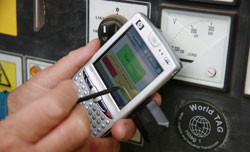
ASSET MANAGEMENT & MAINTENANCE

Making sure that routine maintenance is carried out on tools and equipment is one of the best ways of avoiding time lost through unexpected breakdowns. But, keeping track of equipment that is distributed across many sites can be a problem. Equally with many different pieces of equipment needing different maintenance regimes, staff may have a problem in knowing exactly what should be done when.
RFID provides a way of uniquely identifying tools, plant or components that need to be checked. It can also be used to identify the location of an asset and the identity of the person checking the asset. A system can monitor when assets are checked and prompt staff for relevant inspection or test routines. Businesses can save costs by reducing the time lost through unexpected breakdowns and can reduce the cost of field testing and inspection by providing staff with easy to follow, menu driven, schedules that tell them what needs to be done and collects the data required as part of one simple system. RFID can keep track of seemingly identical components needing preventative maintenance such as in the maintenance of escalator steps at London Underground.
These systems have already proven their worth in a number of areas but the environments in which plant and tool maintenance applications can be demanding. Tags are often subject to difficult conditions. Magnetic fields, electrical fields, moisture and chemicals can all be an issue. CoreRFID understands which tags are best suited to which environment and can advise companies on the best tags to select. To make it easy to introduce asset maintenance applications CoreRFID has developed the Portable Data Collector (PDC) application.
To learn more download our PDC fact sheet, or see how Byzak are using PDC by watching this video. Intelligent, active tags can also provide real time tracking of assets.
CoreRFID's Pro-Found real time location solutions are based on the Ekahau WiFi networking intelligent tags.
A fact sheet on our real time location systems is available.







